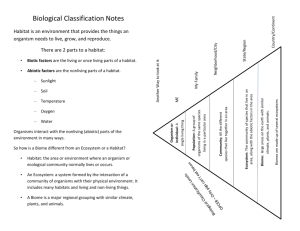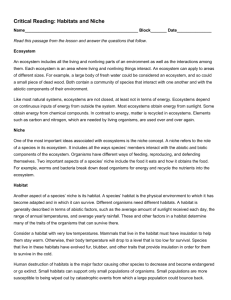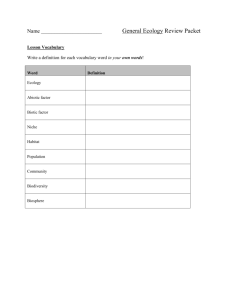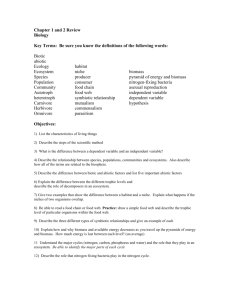The Science of Ecology
advertisement
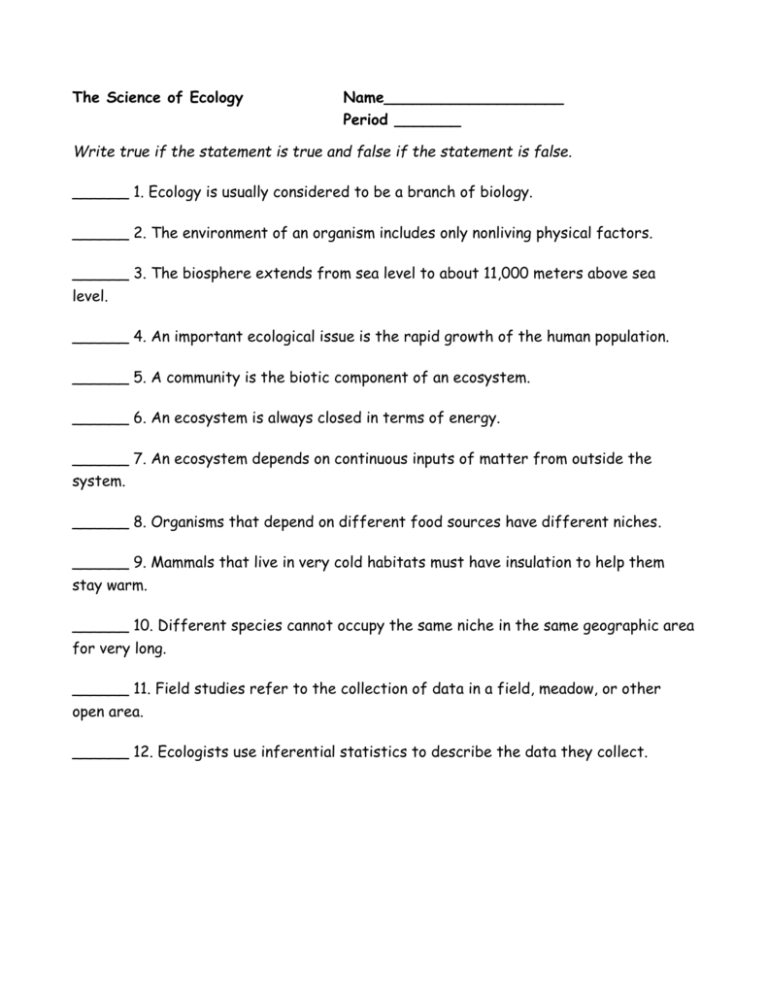
The Science of Ecology Name___________________ Period _______ Write true if the statement is true and false if the statement is false. ______ 1. Ecology is usually considered to be a branch of biology. ______ 2. The environment of an organism includes only nonliving physical factors. ______ 3. The biosphere extends from sea level to about 11,000 meters above sea level. ______ 4. An important ecological issue is the rapid growth of the human population. ______ 5. A community is the biotic component of an ecosystem. ______ 6. An ecosystem is always closed in terms of energy. ______ 7. An ecosystem depends on continuous inputs of matter from outside the system. ______ 8. Organisms that depend on different food sources have different niches. ______ 9. Mammals that live in very cold habitats must have insulation to help them stay warm. ______ 10. Different species cannot occupy the same niche in the same geographic area for very long. ______ 11. Field studies refer to the collection of data in a field, meadow, or other open area. ______ 12. Ecologists use inferential statistics to describe the data they collect. Critical Reading Read this passage from the lesson and answer the questions that follow. Ecosystem An ecosystem is a natural unit consisting of all the living organisms in an area functioning together with all the nonliving physical factors of the environment. The concept of an ecosystem can apply to units of different sizes. For example, a large body of fresh water could be considered an ecosystem, and so could a small piece of dead wood. Both contain a community of species that interact with one another and with the abiotic components of their environment. Like most natural systems, ecosystems are not closed, at least not in terms of energy. Ecosystems depend on continuous inputs of energy from outside the system. Most ecosystems obtain energy from sunlight. Some obtain energy from chemical compounds. In contrast to energy, matter is recycled in ecosystems. Elements such as carbon and nitrogen, which are needed by living organisms, are used over and over again. Niche One of the most important ideas associated with ecosystems is the niche concept. A niche refers to the role of a species in its ecosystem. It includes all the ways species’ members interact with the abiotic and biotic components of the ecosystem. Two important aspects of a species’ niche include the food it eats and how it obtains the food. Habitat Another aspect of a species’ niche is its habitat. A species’ habitat is the physical environment to which it has become adapted and in which it can survive. A habitat is generally described in terms of abiotic factors, such as the average amount of sunlight received each day, the range of annual temperatures, and average yearly rainfall. These and other factors in a habitat determine many of the traits of the organisms that can survive there. Consider a habitat with very low temperatures. Mammals that live in the habitat must have insulation to help them stay warm. Otherwise, their body temperature will drop to a level that is too low for survival. Species that live in these habitats have evolved fur, blubber, and other traits that provide insulation in order for them to survive in the cold. Human destruction of habitats is the major factor causing other species to decrease and become endangered or go extinct. Small habitats can support only small populations of organisms. Small populations are more susceptible to being wiped out by catastrophic events from which a large population could bounce back. Questions 1. What is an ecosystem? Give an example. 2. How do ecosystems obtain energy? 3. What happens to matter in ecosystems? 4. Define niche. What are two aspects of a niche? - 5. What factors make up a species’ habitat? Multiple Choice Circle the letter of the correct choice. 1. Abiotic components of the environment include a. air temperature. b. other species. c. producers. d. all of the above. 2. The chief food producers in the ocean are a. plants. b. zooplankton. c. phytoplankton. d. fish. 3. Coyotes and rabbits that live in the same area a. are in direct competition with each other. b. have a predator-prey relationship. c. belong to the same population. d. have the same niche. 4. Aspects of a species’ habitat include a. the average rainfall it receives. b. the amount of sunlight it gets. c. the range of temperatures it experiences. d. all of above. 5. The niche of a plant includes all of the following except its a. role as a producer. b. need for sunlight. c. use of soil nutrients. d. genetic makeup. 6. According to the competitive exclusion principle, if two species occupied the same niche in the same area, they would a. outcompete species in other niches. b. move to a different habitat. c. be in competition with each other. d. both go extinct. 7. An example of a descriptive statistic is a(n) a. hypothesis. b. summary. c. inference. d. mean. Vocabulary Match the vocabulary term with the correct definition. Term ____ 1. ecology ____ 2. organism ____ 3. abiotic components ____ 4. biotic components ____ 5. biosphere ____ 6. population ____ 7. community ____ 8. ecosystem ____ 9. niche ____ 10. habitat Definition a. living organisms in the environment b. physical environment to which an organism has become adapted c. populations of different species that live in the same area and interact with one another d. scientific study of the interactions of living things with each other and their environments e. role of a species in its ecosystem f. areas of Earth where all organisms live g. life form consisting of one or more cells h. natural unit consisting of all the living organisms in an area together with all the nonliving physical factors of the environment i. nonliving physical aspects of the environment j. organisms of the same species that live in the same area and interact with one another




